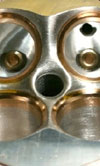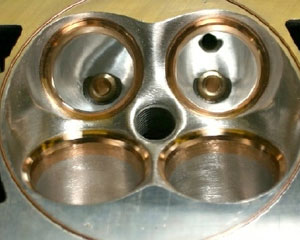Copper alloys in racing engines
 This is the first occasion where we have covered the use of copper alloys, and we shall look briefly at their main applications. Throughout the article the word 'bronze' is used: technically this is a copper alloyed with tin, among other things but bronze has also come to describe many copper alloys such as brasses (copper-zinc alloys) and others.
This is the first occasion where we have covered the use of copper alloys, and we shall look briefly at their main applications. Throughout the article the word 'bronze' is used: technically this is a copper alloyed with tin, among other things but bronze has also come to describe many copper alloys such as brasses (copper-zinc alloys) and others.
In terms of four-stroke con rods, most of us will be familiar with the concept of using a bushed small end. In the vast majority of cases this will be a bronze material, although for higher pressure applications copper-beryllium has also been used with success. There have been occasions where coated high-strength steel has been used, but this is uncommon and bronze alloys continue to be the most popular.
Continuing with bearings, the backing material of bearing shells is still quite often a bronze alloy, although steel is often used now. While not as stiff as steel, the bronze material does have better thermal conductivity.
As we might imagine, most uses for copper are as a bearing alloy, and while the previous two applications are rotating bearings, the next are sliding bearings. In pushrod applications, it is common to machine the block in order to sleeve the lifter bores, and these sleeves are commonly bronze materials. The capabilities of copper alloys as bearing materials are especially valued where keyway lifters are used.
Copper alloys are used extensively as valve guides. This is not only for the bearing characteristics of the materials being used but also thermal conductivity. There are other materials that could be suitable candidates for use as a valve guide, but the various copper alloys in this application offer good wear characteristics and the ability to conduct heat away to the head, allowing the stem seals to operate at a lower temperature and therefore with greater reliability. Copper-nickel-silicon alloys are often used in this application.

For the same reasons, copper alloys are favoured materials for machining valve seat inserts. Here, they need to have good wear characteristics, but also good thermal conductivity as they conduct most of the heat away from the valve and into the head. There are a number of good candidate alloys for this, although many now seem to gravitate towards copper-beryllium for this purpose, often with different alloys being used for inlet and exhaust seats.
In sealing the cylinder liner to cylinder head interface, people often use flat sealing rings, and these are sometimes referred to - mistakenly - as beryllium rings. These have been made from beryllium-copper alloys, although this can be an expensive route to producing these parts, which can perform well in a number of much cheaper alloys, and a number of relatively cheap bronze materials are used successfully.
New alloys with improvements in thermal conductivity and strength are available and we will surely see these alloys being considered for racing engine use in years to come.
Fig. 1 - Cylinder head fitted with copper-beryllium valve seats
Written by Wayne Ward